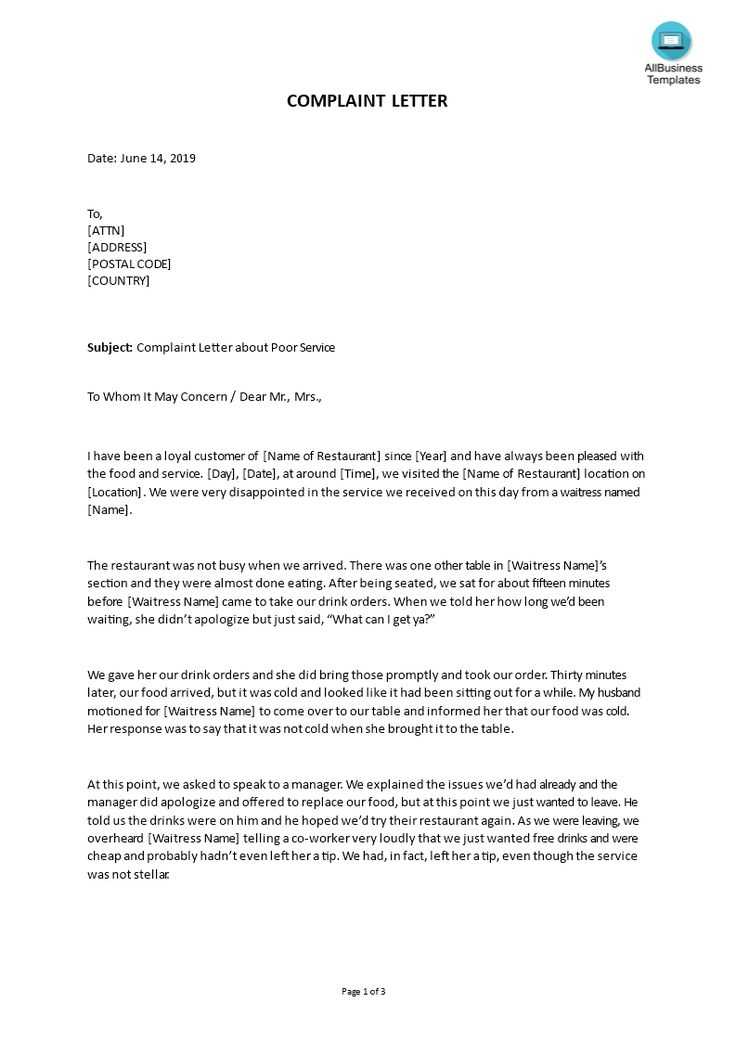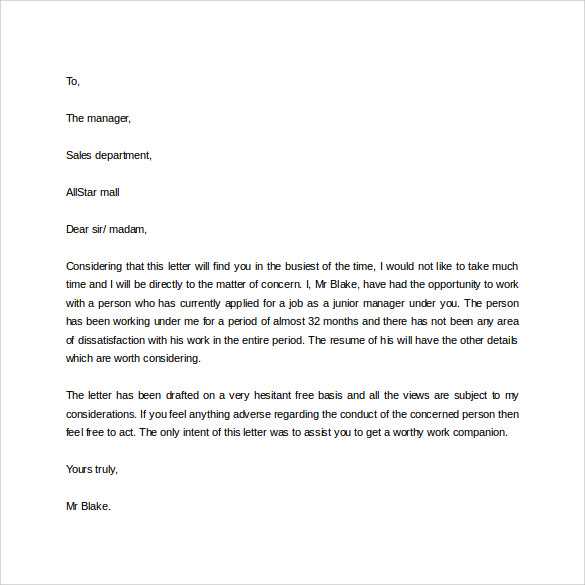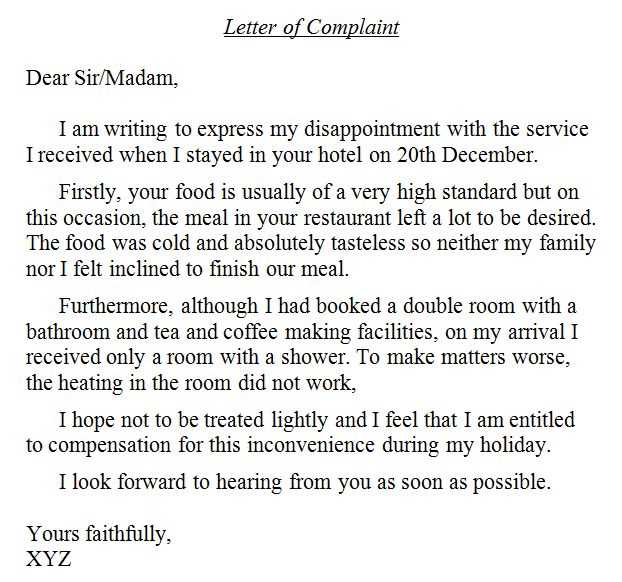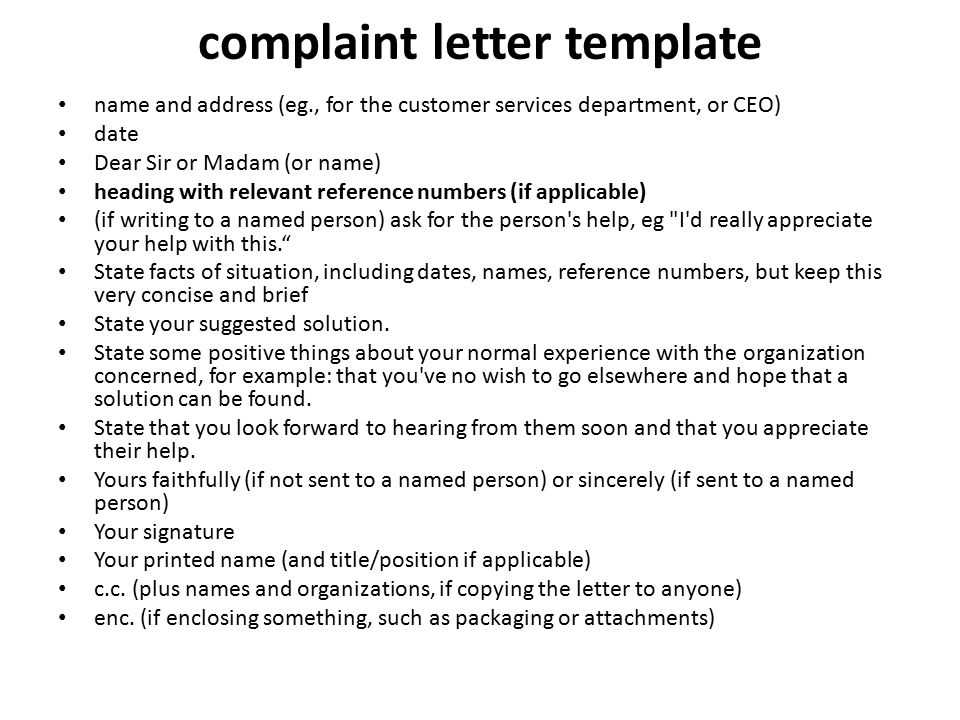Letter of dissatisfaction of service template

To begin addressing a poor service experience, it’s important to clearly express the issue in a direct and constructive manner. The letter should specify what went wrong and why it did not meet your expectations, using clear and concise language. This will help the recipient understand the problem from your perspective.
In the first part of the letter, explain the nature of the service you received. Include relevant dates, people involved, and any other specific details that will help identify the incident. This creates a factual context for your complaint.
The second part should focus on how the service failed to meet your standards. Be specific about the expectations that were not met, whether it was the quality of service, timeliness, or other factors. Avoid generalizations and ensure your tone remains professional, yet firm.
Finally, suggest how the situation could be resolved. Offering a reasonable solution shows that you’re not just complaining but seeking a fair resolution. Whether it’s a refund, a replacement, or an apology, outlining your desired outcome will guide the recipient toward taking the necessary steps.
Letter of Dissatisfaction of Service Template
Begin your letter by clearly stating the issue and the service you are dissatisfied with. Be specific about the service you received and how it did not meet your expectations. Address the company or service provider by name, ensuring your tone is respectful but direct.
For example, you might write: “I am writing to express my dissatisfaction with the recent service I received on [date]. The [product/service] I purchased from [company name] did not meet the standards I was expecting, and the experience was not as advertised.”
Next, provide details about the situation. Include facts like dates, any previous communication, and any actions you’ve taken to resolve the issue. Avoid emotional language or vague descriptions. Stick to the facts to keep the letter clear and professional.
For instance: “I contacted your customer support on [date] regarding the malfunction I encountered, and after waiting for [time], I received no helpful response. This delay in addressing my concerns has been highly disappointing.”
Then, state what you expect as a resolution. Whether you want a refund, replacement, or compensation, make your request clear. Avoid being demanding, but ensure your expectation is reasonable and achievable.
Example: “I would appreciate it if you could resolve this matter by [mention your preferred solution]. I believe this is a fair request given the circumstances.”
Finish your letter with a polite closing. Thank the recipient for their time and express your hope that the issue will be resolved quickly. Provide your contact information in case they need to follow up.
For example: “Thank you for taking the time to address my concerns. I look forward to your prompt response. You can reach me at [phone number] or [email address].”
How to Begin Your Dissatisfaction Letter

Begin by addressing the recipient directly and clearly stating the purpose of your letter. Mention the specific service or product that did not meet your expectations. Provide relevant details, such as order numbers or account information, to help the recipient quickly understand the issue.
State the Problem Clearly
Clearly explain what went wrong. Focus on the facts: dates, times, names of employees (if applicable), and the exact nature of the dissatisfaction. Avoid unnecessary emotions or over-explanation. Stick to the key points to make your complaint easy to follow.
Express Your Disappointment
While keeping a polite tone, let the recipient know that you are dissatisfied with the service. Share how the issue has impacted you and why it matters. This helps convey the seriousness of the situation without sounding hostile.
Clearly Stating the Issue with the Service
Describe the issue directly without ambiguity. Specify what went wrong, whether it was a delay, poor communication, or an unmet expectation. Be clear about the service or product involved, including dates, locations, or relevant details.
Example: “On January 15, I ordered a product from your online store with an expected delivery date of January 20. However, the package has not arrived yet, and there has been no communication regarding any delays.”
Stay factual and avoid emotional language. Focus on the specific service provided and how it fell short of your expectations. This will help the recipient address the issue effectively.
Example: “The technician who was assigned to my appointment on January 10 failed to arrive on time, resulting in an inconvenient delay of two hours.”
Being precise with the details not only clarifies the situation but also gives the service provider a chance to address the matter quickly.
Providing Evidence to Support Your Complaint
Attach any documentation that can directly back up your claims. This can include receipts, emails, contracts, or photographs, depending on the nature of the complaint. Always make sure to provide clear and relevant evidence that ties directly to the issue you are raising.
Include Specific Details
Provide precise information such as dates, locations, names of involved personnel, or specific product details. This shows that you have thoroughly reviewed the situation and are presenting a well-grounded complaint.
Organize Your Evidence
- Label each piece of evidence clearly and in a logical order.
- Highlight key points that directly relate to the problem.
- If possible, provide timestamps or references to easily verify your claims.
Structured evidence not only strengthens your complaint but also makes it easier for the recipient to assess the situation quickly and accurately.
Suggesting an Appropriate Resolution
To resolve a service issue effectively, propose a clear and actionable solution. Start by focusing on the specific problem and suggest a course of action that can directly address it.
- Request a full refund if the service provided does not meet agreed standards.
- Ask for a replacement or re-performance of the service, ensuring that the same issue will not recur.
- Propose a discount or partial refund to compensate for the inconvenience experienced.
- If the issue is minor, suggest an immediate fix or adjustment to the service, along with a follow-up to ensure satisfaction.
- In cases of miscommunication, suggest better communication channels or methods to avoid similar misunderstandings in the future.
Being direct and specific about your expectations will encourage a quicker and more favorable response from the service provider. Always mention a reasonable timeframe for the resolution to ensure both parties have a clear understanding of what to expect.
Maintaining a Professional Tone Throughout
Keep the language clear and courteous. Directly address the issue, avoiding overly harsh or emotional wording. Choose words that reflect a respectful approach while clearly stating dissatisfaction. Phrases like “I am disappointed” or “I expected more” are effective without sounding accusatory. Express your concerns with confidence, but avoid exaggeration or threats that could escalate the situation.
Be Specific, Not Personal

Focus on the service and how it failed to meet expectations. Avoid making personal attacks or assumptions about the service provider’s intent. For example, say “The product did not perform as expected” rather than “You clearly don’t know how to deliver quality service.” Keeping the focus on the service allows the conversation to stay professional.
Maintain Neutrality in Language
Avoid extreme language or blaming words like “always” or “never.” Instead, express your dissatisfaction with measured language. For instance, use “The service was not up to the standard I anticipated” instead of “You never get things right.” This helps keep the tone balanced and more likely to lead to a productive resolution.
Closing Your Letter with Clear Expectations
Conclude your letter by clearly stating the outcome you expect. Be specific about the resolution you’re seeking, whether it’s a refund, replacement, or another action. This helps avoid ambiguity and ensures that both you and the recipient are aligned on what needs to happen next.
Be Direct About Your Request

Clarify what you would like the company or service provider to do. For example:
| Action | Expected Outcome |
|---|---|
| Refund | Receive the total amount charged to my account within 14 days. |
| Replacement | Receive a new, fully functional product within 7 days. |
| Compensation | Receive a voucher for future services as a goodwill gesture. |
Set a Reasonable Timeline
Let the recipient know when you expect a response or resolution. Setting a clear deadline for action gives your letter a sense of urgency. Ensure that the timeline is reasonable based on the nature of your request.